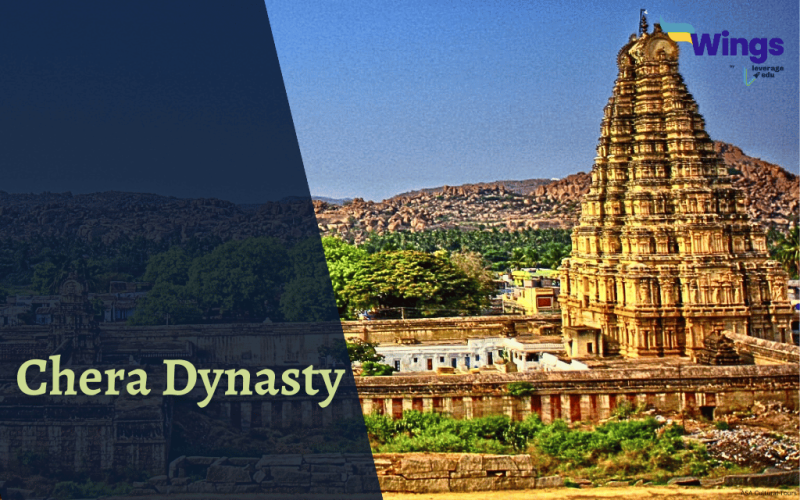The Cheras, also called the Keralaputra were the ancient Dravidians living in Southern India, in the present day Kerala. The first Chera Ruler of the Chera dynasty emerged in the 5th Century BCE and the dynasty reigned in the Sangam Era along with other kingdoms like the Chola and Pandya dynasties. The rulers of this dynasty are known to have unified various regions between the western coast and the western ghats to establish the Chera Empire. Let’s explore more about this ancient Indian kingdom, its rulers, administration and conquests.
Table of Contents
Origin Of The Chera Dynasty
The Cheras had control over Kerala and Tamil Nadu including areas of Malabar, Cochin and Travancore. The first capital of the Chera rulers was Vanchi which was later shifted to Kulasekharapuram. They ruled between the 4th to 5th centuries BCE and then from the 8th Century BCE to the 12th Century BCE. Bow and arrow was the emblem of this Dynasty. The country of Chera was placed in a geographically profitable area as it could gain an advantage from the maritime trade via the extensive Indian Ocean networks. Some of the common trades that took place were Indian spices, pearls, gems, timber etc.

Rulers
As per Tamil Sangam Scriptures, Uthiyan Cheralathan was the first ruler of the Chera Dynasty ruling the Kuzhumur in Kuttanad, Kerala. As for the later Cheras, Kulasekhara Alwar is considered to be the first ruler. Here are some of the important rulers of the Chera Dynasty.
- Uthiyan Cheralathan – Reign from 1st to 3rd century AD
Was the first Chera ruler and established his capital in Kuzhumur, Kuttanad. He later expanded his kingdom northward.
2. Kulashekhara Alwar – Reign 800 – 820 AD
He is said to have invaded the Chola and Pandya lands during his rule. His flawless administration quickly gained him prominence. He later retired as a saint.
3. Rama Varma Kulasekhara – Reign from 1090–1102 AD
Known to be the last ruler of the Chera Perumal Dynasty his reign came in a period of great struggle between the Cholas and Cheras. He overcame the Cholas but abdicated the throne due to internal conflicts within the empire due to his hostility towards the Brahmins.
Also Read: The Nanda Empire: Rise, Reign, and Fall
Administration of Chera Dynasty
The political structure followed by the Cheras was a monarchy with the king being a celebrated figure. The queen was also given great importance, shadowing the king in all important ceremonies. The Shilappadikaram was the king’s council and there were five assemblies in the administrative structure.
The king’s council was also responsible for judicial decisions. The kingdom was divided into four provinces, each with a chief minister who was entitled to great power. In the process of making decisions, the chief priestess and the chief astrologer were also great advisories.
Each village in the kingdom had a Manram institute to look after the village proceedings. It was structured like a panchayat with the members conducting meetings under a Banyan tree. The administrative structure of the Cheras was therefore very extensive in creating policies and rendering judgements.

Life of Cheras
Dravidian religions were popular among the Cheras which involved making sacrifices to a supreme god, Murugan. Moreover, the early Tamil texts also suggest the use of social stratification in society. Most of the temples in this period were octagonal which was a specific feature of the Dravidian architecture.
The economic system of the Cheras was led by agriculture. The agrarians were involved in trade with the Romans who are denoted as Yavanas in their texts. Also, the chief export involved in this business was of spices, especially black pepper. For this, the traders paid large amounts in Gold.
The Pathitrupathu, Akananuru, and Purananuru are the most famous literary works of the Cheras. They talk about the life, lifestyle, rule and administration of the kingdom under the rulers. The kingdom also proudly harboured some poets and philosophers.
Also Read: Indus Valley Civilization: Time-Period, Culture & Excavation Sites
Economy of the Chera Dynasty
The Chera Dynasty’s economy in its early stages was based on a combination of agriculture and pastoral activities, alongside trade. Over time, agriculture became more prevalent and served as the foundation for larger economic changes.
- Graeco-Roman merchants had trade relations with the Chera Dynasty. The Yavanas, also known as Greeks, played an important role in driving the Chera Dynasty’s economy.
- The Chera Dynasty had a common practice of trading spices with the Middle East and Mediterranean region.
- The Periplus Maris Erythraei, a navigation guide, documents the trade in Keprobotras. According to the Periplus, Muziris was the most significant trade centre on the Malabar Coast.
- Bulk exports from the Chera Dynasty included spices, ivory, timber, pearls, and gems to the Middle East and Mediterranean regions.
- The Chera Dynasty was famous for producing the finest steel in the world, and this steel was exported to foreign countries in the form of steely iron cakes known as “Wootz.”

Decline of the Chera Dynasty
The constant wars between the Cheras and the Cholas expanded over a period of 100 years. This weakened the Chera empire in terms of having a central administration. Taking advantage of this situation influential and powerful chiefs of the kingdom proclaimed independence of their provinces.
Relevant Blogs
| Haryanka Dynasty | Satavahana Dynasty |
| Gupta Empire | Chola Dynasty |
| Mauryan Empire | Pallava Dynasty |
| Chalukya Dynasty | Khilji Dynasty |
This blog was all about the Chera Dynasty. Stay informed about Indian history and broaden your general knowledge with our dedicated section.
 One app for all your study abroad needs
One app for all your study abroad needs













